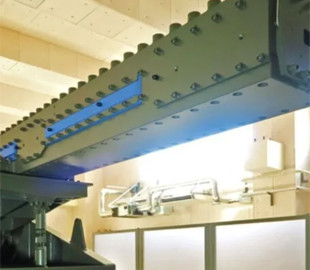Japan's Acquisition, Technology and Logistics Agency (ATLA) has announced the completion of the terms of reference phase for cooperation with France and Germany in the technology required to develop electromagnetically-propelled projectile weapons. Such a gun is also known as a railgun or railgun. Defense Romania writes about this.
Just recently, the Japanese side sent a delegation to the States so that experts could get acquainted with the American experience in the development of this technology. The USA itself has temporarily suspended the development of its railgun.
A railgun is a modern electromagnetic weapon that uses magnetic fields generated by strong electric currents to propel projectiles to extremely high velocities. The main difference between an electromagnetic gun and a classic artillery gun, in which a powder charge is used to throw a projectile, is that a powerful magnetic force is used in the reikotron to launch the projectile.
The basic components of the railgun consist of a power source, two parallel metal guides (rails) and conductive fittings. When an electric current passes from the power source through the guides and armature, a strong electromagnetic field is created around the rails. In turn, this field initiates electromagnetic energy (the Lorentz force) that moves the anchor and the projectile attached to it at very high speeds.
Defense Romania calls the main advantage of relsotrons over classic artillery systems that they allow projectiles to be launched over long distances at very high speeds without the use of projectile charges. That is, with much lower financial costs. In addition, projectiles of electromagnetic guns have smaller sizes and are the most difficult to detect. In addition, the projectiles of such guns can hit targets at greater distances with higher accuracy. It is assumed that some samples of railguns will be able to fire at distances of up to 400 kilometers.
However, relsotrons have their drawbacks. The main one is the need for huge amounts of electricity, which will require advanced power systems capable of withstanding millions of amperes of current. In addition, the strong thermal and mechanical loads that occur during firing create problems with the durability of the materials used in the construction of railguns.
According to Defense Romania, in 2021 Japan presented a prototype of a medium railgun capable of launching a projectile weighing 320 grams with an initial speed of 2230 m/s. The weapon uses a current charge energy of 5 MJ. Japanese designers have ambitions to increase this energy to 20 MJ. Subsequently, Japan provided $56 million for the implementation of the railgun project. The project itself is designed for the period until 2028.
As for the US efforts to develop an electromagnetic gun, the president of the non-profit US Missile Defense Alliance, Ricky Ellison, stated as early as 2022 that the weapon was “recognized for operational deployment”. The statement was made almost immediately after the Pentagon abandoned the project. The U.S. Navy spent ten years and $500 million developing railgun technology before abandoning its efforts in the summer of 2021 to focus on developing hypersonic missiles.

